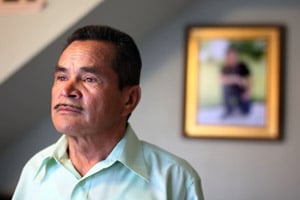Written by Marian Wang
 California gardener Francisco Reynoso’s son died in a car accident in 2008, burying the father in student debt. Now, four years later, Reynoso has finally reached a legal resolution. (J. Emilio Flores for ProPublica)
California gardener Francisco Reynoso’s son died in a car accident in 2008, burying the father in student debt. Now, four years later, Reynoso has finally reached a legal resolution. (J. Emilio Flores for ProPublica)
It’s been four long years for Francisco Reynoso. The California gardener whose son died in a car accident in 2008 was left buried in grief — and in student debt. At last, the bereaved father is getting some resolution.
As ProPublica reported in June, Reynoso was saddled with six figures in student loans that he had cosigned for his son, Freddy Reynoso, to attend college. According to his 2011 tax returns, the elder Reynoso made just $21,000. Debt collectors harassed him. His son’s federal student loan was forgiven upon his death, but because the bulk of the loans were private, Reynoso was left at the mercy of unfamiliar financial firms, Wall Street investors, and even the central bank of a foreign country.
Have you had problems with the servicing of your student loans or with your lender? We’d like to hear from you.
ProPublica traced the complex loan trail of Freddy Reynoso’s student loans, which broke down into two main parts. For the first, Reynoso had borrowed from a bank with a household name — Bank of America. That debt changed hands and was ultimately sold to investors through a company neither he nor his father had ever heard of: First Marblehead, once one of the biggest securitizers of private student loans.
Through the bankruptcy process, that portion of Reynoso’s debt has now been discharged. Court filings show that First Marblehead’s National Collegiate Trust — its name for its student loan securities — decided not to dispute the discharge attempt.
But the other set of loans — the larger portion of Reynoso’s debt — took an even stranger path. Originated by a company later accused of paying schools to steer students toward its loans products, his loans passed through Swiss bank UBS and landed in a portfolio of assets that were acquired by the Swiss central bank to stabilize UBS during the financial crisis.
That fund, known as the StabFund, has reached a settlement agreement with Reynoso’s attorney. It’s not known whether the settlement, which binds all parties to a confidentiality agreement, will still require Reynoso to pay on his debts.
Andrew Bao, an attorney representing the StabFund, declined comment and promptly hung up on a ProPublica reporter. Erik Clark, Reynoso’s attorney, also declined to discuss the case because of the confidentiality agreement.
Speaking generally about the challenges of cases involving opaque private student loans that have been sold and resold, Clark said: “From an attorney’s perspective, when you try to settle or negotiate, the real problem is figuring out who you’re supposed to be talking to. If someone is calling the client and harassing them, you’re not sure that’s who you’re supposed to deal with.” That’s partly because the holder of the loan often contracts with third-party servicers or debt collectors that don’t have authority over the debt. And, Clark says, sometimes such companies won’t divulge who holds the debt.
The current legal standard for discharging a student loan through bankruptcy is “unreasonably high as interpreted,” he said, rendering most student loans generally non-dischargeable.
“What I tell people — almost everyone who comes to me — is this is going to require a political solution,” said Clark. “People in this situation should be getting politically active and talking about this issue to congressmen. Someone has to be ringing the fire bell.”
As for Reynoso — the man who has now suffered for four long years — his financial future remains hazy. He’s aware that one of his debts has been discharged. But even now, he’s not sure about what’s happened with the rest because the final paperwork remains to be signed. Asked whether he knows if he will end up having to pay in the end, Reynoso replied that he didn’t.

